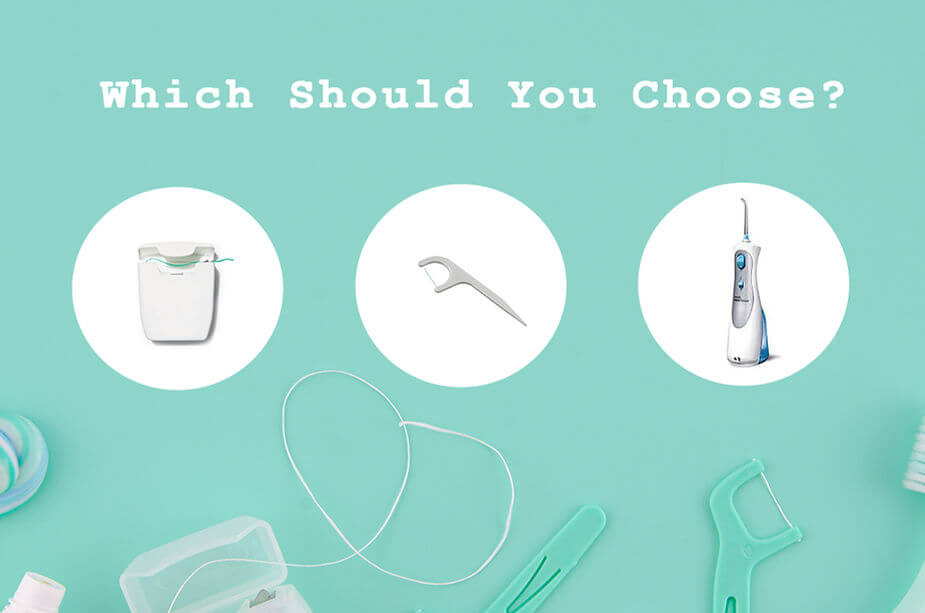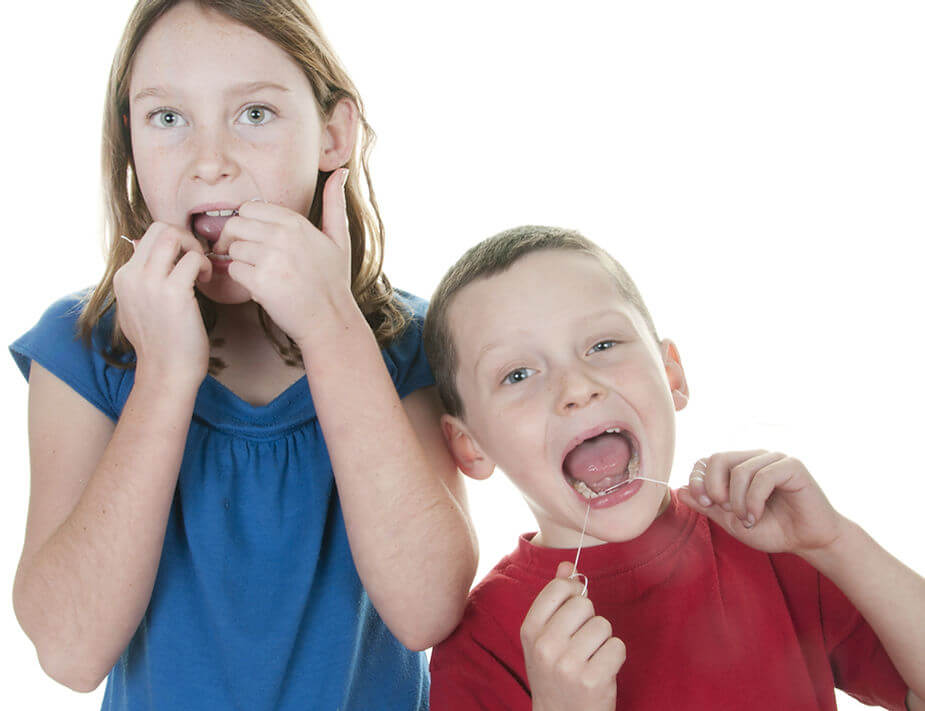Floss, Floss Picks, or Water Flossers: Which Should You Choose?
It is common knowledge that flossing is just as important as brushing your teeth, but there are so many options on the market, how can you know what is best? We are going to explain the different types of flossing products and help you understand which options work, which can be harmful, and what Dr. Culp recommends.

Types of Flossing Tools
Floss vs. Floss Picks
Researchers have found that floss and floss picks seem to have similar results if you use good flossing technique. Traditional floss can be a bit easier to curve around the tooth, but with a bit of care, you can do the same with floss picks.
Floss picks can be easier to use, especially for younger children. They also help you reach the back of your mouth with less maneuvering.
Whether you choose traditional floss or floss picks, the most important thing is that you floss once a day. When you are comfortable using one type of flossing tool, you are more likely to floss regularly. So, make the choice that works for you.
Water Flossers
Water flossers aim a stream of water at your teeth. They are good for rinsing bigger pieces of food debris from around braces and between teeth but are not a good substitute for regular floss. They do not remove bacteria and plaque from teeth like traditional floss and floss picks do. Use a water flosser if you want but be sure to also use floss or a floss pick every day.
Interdental Brushes
Interdental brushes are small brushes that are used between the teeth. They are good for cleaning under the wire of braces but can actually injure the gum tissue if not used very carefully. Dr. Culp does not recommend that young people use interdental brushes.
Why should we floss?
Flossing dislodges food and bacteria between teeth where toothbrushes cannot reach and reduces plaque (1, 3). Less food, bacteria, and plaque on your teeth mean that you lower your risk of developing tooth decay. If you floss once a day, in addition to brushing twice a day, it also reduces your chances of developing gingivitis (1).
Unfortunately, most adults do not floss every day. Just 31.6 % of adults surveyed said that they floss every single day. 36.5 % floss between 1 and 6 days per week and 31.9 % said they never floss (2).
Since flossing helps your mouth stay healthy by removing food particles, harmful bacteria, and plaque, people who do not floss daily are missing a great opportunity. Since the health of your mouth impacts your health in other ways, the simple act of flossing is an easy way to keep yourself healthy.
What about flossing with braces?
It is just as important to floss when you have braces. Keeping your teeth and gums clean and healthy can shorten your treatment time. Neglecting oral hygiene while you have braces can lengthen your treatment time and cause lasting damage to your teeth and gums.
Luckily, there are now floss picks designed specifically for people with braces. Plackers Orthopick® Flossers or Platypus Orthodontic Flossers are great options if you have braces.
Tips for Kids
- Begin the habit now. If most adults do not floss every day, chances are their children do not either. It is never too late to start a healthy habit. Childhood is an optimal time to create healthy patterns that last a lifetime. Kids learn by example, so your whole family will benefit if you add flossing into your daily routine.
- Start Young. As soon as a child has two teeth right next to each other, it is important to begin flossing their teeth every day.
- Help until they are 10. Most kids will not have the dexterity to floss well enough on their own until somewhere between the ages of 8 and 10. Once they are physically able to start flossing, let them floss before or after you do but be sure that an adult also flosses for them until they are doing a great job every time. Even after they are flossing well on their own, it is a good idea to periodically floss for them. This way you can see if there are any inflamed areas or places that bleed. This will let you know to keep an eye on the area and bring it up at their next dental appointment if it doesn’t clear up.

Tips for Flossing
- Floss before you brush. Research has shown that people who floss before they brush have less plaque between their teeth than those who floss after brushing (3).
- Gently glide the floss up and down between your teeth, all the way down into the gum line.
- Be gentle with your gums. Try not to snap the floss against your gums so you do not injure them.
- As the floss reaches your gum, gently curve it around the base of one tooth, then do it again for the neighboring tooth.
- Look in the mirror as you floss. This is a great way to identify problem areas. If you are using a floss pick, you can also see if there are particles on the floss or if it is beginning to shred. If there is debris, it is a good idea to rinse the floss. If it is shredding, throw that floss pick away and use a new one for the rest of your teeth.
- Use a new floss pick or strand of floss every day. Used floss does not work as well and bacteria can grow on it overnight, which will defeat the whole purpose of cleaning your teeth.
Flossing is a simple thing to do to sustain a healthy mouth and body and it only takes a couple of minutes a day. Prevention is the best strategy for a healthy mouth, and flossing is a key component in preventing cavities and gum disease. If you have any questions about flossing or need help encouraging your family to start a daily flossing habit, we would love to help. Feel free to reach out with any questions or bring it up at your child’s next appointment.
- Whether the snack food is sticky or chewy. This is important because it stays on the teeth longer.
- How long will the food remain in the child’s mouth? (Is it a piece of licorice or hard candy?)
- How often will the child be consuming this snack product? (If it’s rare, it’s less damaging than if consumed daily or multiple times per day.)
Always choose snacks that allow minimal time for sugar to remain on the teeth. Remember, foods like pretzels, juice, applesauce, or yogurt can be a source of hidden sugar.
Now that we’ve covered the basics of abscessed teeth, you should have a better idea about their typical causes, common ways they are diagnosed, best methods of prevention, and treatment options. If you think your child may have an abscessed tooth, be sure to call us right away to schedule an appointment. Even if you don’t suspect an abscess, don’t forget to discuss your child’s oral hygiene routine and eating/drinking habits during your next appointment with us. This information can help to make sure their habits are in line with maintaining the healthiest possible teeth and smile. We look forward to seeing and hearing from you!

At Jungle Roots Children’s Dentistry & Orthodontics, we strive to provide the highest comprehensive pediatric and orthodontic dental care in a unique, fun-filled environment staffed by a team of caring, energetic professionals. We believe the establishment of a “dental home” at an early age is the key to a lifetime of positive visits to the dentist.
Call Us - (480) 759-1119
#ahwatukee#Arizona#chandler#dental#dentalcare#dentist#dentistry#floss#flosspicks#health#JungleRoots#mom#OralHealth#PediatricDentistry#phoenix#wellbeing#wellness
- Worthington, Helen V et al. “Home use of interdental cleaning devices, in addition to toothbrushing, for preventing and controlling periodontal diseases and dental caries.” The Cochrane database of systematic reviews vol. 4,4 CD012018. 10 Apr. 2019, doi:10.1002/14651858.CD012018.pub2 https://www.ncbi.nlm.nih.gov/pmc/articles/PMC6953268/
- Fleming, Eleanor B et al. “Prevalence of daily flossing among adults by selected risk factors for periodontal disease-United States, 2011-2014.” Journal of periodontology vol. 89,8 (2018): 933-939. doi:10.1002/JPER.17-0572 https://www.ncbi.nlm.nih.gov/pmc/articles/PMC6434526/
- Mazhari, Fatemeh et al. “The effect of toothbrushing and flossing sequence on interdental plaque reduction and fluoride retention: A randomized controlled clinical trial.” Journal of periodontology vol. 89,7 (2018): 824-832. doi:10.1002/JPER.17-0149 https://pubmed.ncbi.nlm.nih.gov/29741239/?from_term=floss+or+floss+picks&from_pos=6.


















